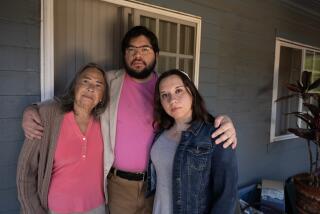Today’s Agenda
- Share via
Elaborate, spray-painted initials on every available flat surface, sometimes sprinkled with obscenities--whether by gang members or “taggers,” scrawled or carefully formed, we generally see it all as ugliness, as violation, as a threat to the well-being of our neighborhoods. But what’s the impulse behind graffiti? What’s the best way to stop it? Is it ever art?
In a special page today on graffiti, a lively debate emerges on all of these issues, even the definition of the word. Sharon Gordon Donnan and Diane Alexander, founding members of the Graffiti Arts Coalition, draw a hard line between tagging and true graffiti, which they define as urban murals, or Hip Hop art. Their In Dispute feature calls for special programs and legal spaces for multiracial Hip Hop crews to practice their craft, to substitute vibrant images for violence in the streets.
That still leaves the problem of tagging, which has spread to every sort of neighborhood, in every part of Southern California. One of the most successful programs for eradicating it is Anaheim’s. Its active, responsive and mostly volunteer program is the subject of Making a Difference. Remarkable features of Anaheim’s effort are its low cost and the speed with which new tags are painted out.
Speed is the critical issue, argues a Los Angeles prosecutor in Platform. But isn’t that like covering a skin cancer with a coating of skin-like substance, responds a muralist who works with graffitists--what do we do about the alienation that propels these kids? We find out more about that alienation in the Youth opinion, where former gang member Christina Diaz talks about why she joined the gang, why she tagged everything in sight and how she got out.
By economic definition, the people who run our schools are middle-class. And this, says teacher Norah Cunningham, means that all students are treated with middle-class expectations, divided into “real” students whose images come to mind when teachers talk about “our class” and those who are strangers, who are outsiders, who are poor. In Community Essay, Cunningham charges that our schools glamorize ethnic diversity but ignore socioeconomic differences. Students are written off as hostile or hopeless because they don’t attend school functions, don’t come through with fees they “agreed” to pay, are absent for reasons they’re too ashamed to explain. By expecting all students to share a middle-class upbringing, Cunningham says, teachers unintentionally undermine poor children, who sometimes cannot even articulate their own suffering. When teachers admit to their unspoken class prejudice, students can begin to trust and reveal who they really are.
M alcolm X has plenty to teach Koreans about their subjugation at the hands of the Japanese, says a commentary in the Korea Times English Edition. Also in Second Opinion, a call from the Lesbian News for gays and lesbians to boycott Colorado for its anti-homosexual vote: no exceptions, no excuses.
And in Gripe, a Santa Monican asks whether the city hasn’t gone overboard to court tourists at the expense of residents.
More to Read
Sign up for Essential California
The most important California stories and recommendations in your inbox every morning.
You may occasionally receive promotional content from the Los Angeles Times.













